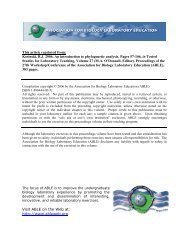Marigold Cell Size and Polyploidy - Association for Biology ...
Marigold Cell Size and Polyploidy - Association for Biology ...
Marigold Cell Size and Polyploidy - Association for Biology ...
You also want an ePaper? Increase the reach of your titles
YUMPU automatically turns print PDFs into web optimized ePapers that Google loves.
128 <strong>Cell</strong> <strong>Size</strong> <strong>and</strong> <strong>Polyploidy</strong><br />
Student Outline<br />
Growing plants (20 minutes initial setup, @ 1 month <strong>for</strong> plants to grow.)<br />
Students should work in pairs or groups. Each pair should fill three small cups with potting soil.<br />
Bury 3-4 diploid seeds in one cup, 1/8 inch deep. Label the cup with the seed type <strong>and</strong> its ploidy<br />
level (e.g. diploid 2X Orange Lady). Repeat <strong>for</strong> the triploid <strong>and</strong> tetraploid varieties, each in its own<br />
cup. Thoroughly water the seeds <strong>and</strong> place the cups in a moderately warm, sunny spot. If the<br />
classroom has no windows they may be grown under artificial lights or at the students’ homes.<br />
Seeds should germinate within two or three days. After germination collect data on growth, such as<br />
height <strong>and</strong> number of leaves, as determined by your instructor.<br />
Questions that might be asked be<strong>for</strong>e doing the guard cell measurements might be to determine if<br />
one ploidy type grows faster than another, whether one has bigger leaves, <strong>and</strong> whether the seed sizes<br />
vary among the different types.<br />
Painting leaves with fingernail polish (15-20 minutes)<br />
You will use clear nail polish to view the surface cell structures. As the nail polish dries it<br />
con<strong>for</strong>ms to the shape of the surface of the leaf, <strong>and</strong> when peeled off it contains an imprint of each<br />
cell. The advantage of looking at the peel rather than the actual leaf surface under the microscope is<br />
that you do not have to repeatedly focus up <strong>and</strong> down through the cell layers <strong>and</strong> decide where the<br />
cell boundaries are.<br />
Each pair should:<br />
1. Collect one leaf lobe from a leaf of the diploid plant.<br />
2. Place the leaflet in a microcentrifuge tube labeled with the partner’s initials <strong>and</strong> ploidy<br />
level.<br />
3. Repeat steps 1 <strong>and</strong> 2 <strong>for</strong> the triploid <strong>and</strong> tetraploid plants.<br />
4. Working on a paper towel, paint the top of each leaflet with clear nail polish.<br />
5. Let the polish dry to the touch – about 15 minutes. (If not properly set it will stretch<br />
while removing it, distorting the cell impressions.)<br />
6. Firmly apply a piece of tape to one end of the nail polish <strong>and</strong> carefully pull the polish off<br />
the leaf.<br />
7. Place each peel <strong>and</strong> tape on a separate microscope slide, <strong>and</strong> carefully label each slide.<br />
Place a cover slip over the peel. Discard the leaf.<br />
8. View each slide under a microscope – the surface should look like Figure 1. In marigold<br />
the guard cell pairs <strong>for</strong>m an ellipse surrounding the stomatal opening. Swelling <strong>and</strong><br />
shrinking of the two guard cells controls the size of opening.
















